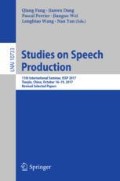Abstract
Recently, increasing attention has been directed to the study of the speech emotion recognition, in which global acoustic features of an utterance are mostly used to eliminate the content differences. However, the expression of speech emotion is a dynamic process, which is reflected through dynamic durations, energies, and some other prosodic information when one speaks. In this paper, a novel local dynamic pitch probability distribution feature, which is obtained by drawing the histogram, is proposed to improve the accuracy of speech emotion recognition. Compared with most of the previous works using global features, the proposed method takes advantage of the local dynamic information conveyed by the emotional speech. Several experiments on Berlin Database of Emotional Speech are conducted to verify the effectiveness of the proposed method. The experimental results demonstrate that the local dynamic information obtained with the proposed method is more effective for speech emotion recognition than the traditional global features.
Access this chapter
Tax calculation will be finalised at checkout
Purchases are for personal use only
References
Johar, S.: Emotional speech recognition. Emotion, Affect and Personality in Speech. SECE, pp. 35–41. Springer, Cham (2016). https://doi.org/10.1007/978-3-319-28047-9_5
El Ayadi, M., Kamel, M.S., Karray, F.: Survey on speech emotion recognition: features, classification schemes, and databases. Pattern Recogn. 44, 572–587 (2011)
Wollmer, M., Schuller, B., Eyben, F., Rigoll, G.: Combining long short-term memory and dynamic bayesian networks for incremental emotion-sensitive artificial listening. IEEE J. Sel. Top. Sign. Process. 4, 867–881 (2010)
Schuller, B., Rigoll, G.: Timing levels in segment-based speech emotion recognition. In: INTERSPEECH 2006 - ICSLP, pp. 1818–182. (2006)
Jeon, J.H., Xia, R., Liu, Y.: Sentence level emotion recognition based on decisions from subsentence segments. In: IEEE International Conference on Acoustics, Speech and Signal Processing (ICASSP 2011), pp. 4940–4943. IEEE (2011)
Zhang, H., Warisawa, S.I., Yamada, I.: An approach for emotion recognition using purely segment-level acoustic features. In: International Conference on Kanesi Engineering and Emotion Research (KEER 2014), pp. 39–49. Linköping University Electronic Press (2014)
Rao, K.S., Koolagudi, S.G., Vempada, R.R.: Emotion recognition from speech using global and local prosodic features. Int. J. Speech Technol. 16, 143–160 (2013)
Gangamohan, P., Kadiri, S.R., Yegnanarayana, B.: Analysis of emotional speech—a review. In: Esposito, A., Jain, Lakhmi C. (eds.) Toward Robotic Socially Believable Behaving Systems - Volume I. ISRL, vol. 105, pp. 205–238. Springer, Cham (2016). https://doi.org/10.1007/978-3-319-31056-5_11
Ververidis, D., Kotropoulos, C.: Emotional speech recognition: resources, features, and methods. Speech Commun. 48, 1162–1181 (2006)
Ververidis, D., Kotropoulos, C.: Emotional speech classification using Gaussian mixture models. In: IEEE International Symposium on Circuits and Systems (ISCAS 2005), pp. 2871–2874. IEEE (2005)
Han, K., Yu, D., Tashev, I.: Speech emotion recognition using deep neural network and extreme learning machine. In: INTERSPEECH 2014. International Speech Communication Association (2014)
Sánchez-Gutiérrez, M.E., Albornoz, E.M., Martinez-Licona, F., Rufiner, H.Leonardo, Goddard, J.: Deep learning for emotional speech recognition. In: Martínez-Trinidad, J.F., Carrasco-Ochoa, J.A., Olvera-Lopez, J.A., Salas-Rodríguez, J., Suen, Ching Y. (eds.) MCPR 2014. LNCS, vol. 8495, pp. 311–320. Springer, Cham (2014). https://doi.org/10.1007/978-3-319-07491-7_32
Burkhardt, F., Paeschke, A., Rolfes, M., Sendlmeier, W.F., Weiss, B.: A database of german emotional speech. In: INTERSPEECH 2005, pp. 1517–1520. International Speech Communication Association (2005)
Boersma, P., Weenink, D.: Praat: doing phonetics by computer (2013)
Schuller, B.W., Steidl, S., Batliner, A.: The INTERSPEECH 2009 Emotion Challenge. In: INTERSPEECH 2009, pp. 312–315. ISCA (2009)
Eyben, F., Weninger, F., Gross, F., Schuller, B.: Recent developments in openSMILE, the Munich open-source multimedia feature extractor. In: the 21st ACM international conference on Multimedia (MM 2013), pp. 835–838. ACM (2013)
Schuller, B.W.: Audio features. Intelligent Audio Analysis, p. 62. Springer, Heidelberg (2013). https://doi.org/10.1007/978-3-642-36806-6_6
Hall, M., Frank, E., Holmes, G., Pfahringer, B., Reutemann, P., Witten, I.H.: The WEKA data mining software: an update. ACM SIGKDD Explor. Newslett. 11, 10–18 (2009)
Acknowledgements
The research is supported partially by the National Basic Research Program of China (No. 2013CB329303), and the National Natural Science Foundation of China (No. 61503277 and No. 61303109). The study is supported partially by JSPS KAKENHI Grant (16K00297).
Author information
Authors and Affiliations
Corresponding authors
Editor information
Editors and Affiliations
Rights and permissions
Copyright information
© 2018 Springer Nature Switzerland AG
About this paper
Cite this paper
Guan, H., Liu, Z., Wang, L., Dang, J., Yu, R. (2018). Speech Emotion Recognition Considering Local Dynamic Features. In: Fang, Q., Dang, J., Perrier, P., Wei, J., Wang, L., Yan, N. (eds) Studies on Speech Production. ISSP 2017. Lecture Notes in Computer Science(), vol 10733. Springer, Cham. https://doi.org/10.1007/978-3-030-00126-1_2
Download citation
DOI: https://doi.org/10.1007/978-3-030-00126-1_2
Published:
Publisher Name: Springer, Cham
Print ISBN: 978-3-030-00125-4
Online ISBN: 978-3-030-00126-1
eBook Packages: Computer ScienceComputer Science (R0)

